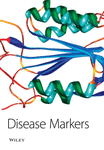HLA and Bronchopulmonary Dysplasia Susceptibility: A Pilot Study
Abstract
There is little data on the association between Human Leucocyte Antigen (HLA) alleles and Bronchopulmonary Dysplasia (BPD) of the preterm newborn. Our aim was to assess associations between HLA alleles and BPD susceptibility. We studied 156 preterm neonates (82 M/74 F) < 32 weeks gestational age, alive at 36 weeks gestational age. Detailed clinical data were collected. HLA typing was performed by PCR-SSO. HLA allele frequencies where determined by direct counting for BPD and no-BPD groups. Comparison between BPD and no BPD groups was performed using t-test, χ2 test or Fisher exact test and logistic regression as appropriate. Relative risks (RR) and their 95% confidence intervals (95% CI) were also calculated as association measures. We diagnosed 56 (35.9%) neonates with mild BPD and 27 (17%) with moderate/severe BPD. We found a significant association between HLA-DRB1*01 and mild BPD (OR=3.48[1.23–10.2]). The alleles HLA-A*24, -A*68, -B*51,-Cw*07, -Cw*14, -Cw*15 and -DRB1*01 presented a significant association with moderate/severe BPD. When adjusted to gestational age and birth weight HLA-A*68 (OR=5.41[1.46; 20.05]), -B*51 (OR=3.09[1.11; 8.63]) and -Cw*14 (OR=4.94[1.15; 21.25]) were significantly associated with moderate/severe BPD. Conclusion – Our findings suggest an association between HLA-A*68, -B*51 and -C*14 and BPD susceptibility, and that an autoimmune mechanism may be implicated in the pathogenesis of the disease.




